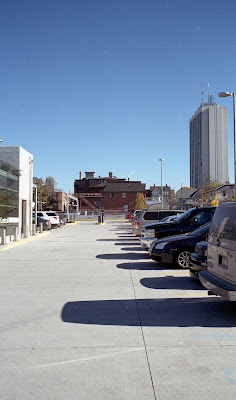Many months ago, Mike Raso of the
Film Photography Project asked me if I thought Ann Arbor would be a good spot to hold a one-day photowalk, and if the
Ann Arbor Area Crappy Camera Club would be interested in assisting/participating. I immediately said "Yes!" I knew that people would love photographing here, and the added attraction of the
Argus Museum would be another plus. So, we made the plans, Leslie Lazenby and I got together and coordinated the schedule, and hoped for the best. Nearly 60 people pre-registered for the FPP Ann Arbor PhotoWalk, which was held on October 3.
On Friday, Oct. 2, Mike Raso met me downtown for lunch, and that evening, Leslie, Mike, and I stuffed the goody bags for the attendees and firmed up what we would be doing the next day. Saturday dawned chilly, windy, and a possibility of rain. Undaunted, photographers started showing up at our rendezvous point at
CameraMall before 9:30 am. Desmond, Craig, and Christy were there to greet us with hot coffee, doughnuts, water, apples, granola bars, and more. People were thrilled to have a real camera store to shop at and come in from the cool weather, and the place really had a vibe going.
Eventually, we split into several smaller groups, led by A3C3 members, and headed around the campus area and downtown to show off our town and get people shooting away. Film cameras were clicking, from Dianas to Hasselblads. It was a fun group of people-- some coming from as far away as California, Vancouver, North Carolina, Tennessee, Ontario, Minnesota, and New Jersey. The participants were in good spirits the entire day, and while the weather got us damp, nobody complained.
After we split up for lunch, we then reassembled at 2:30 at our second rendezvous, the Argus Museum. It is the ONLY camera museum that is in the same building where the cameras were once made. Cheryl Chidester and her volunteers had cider and doughnuts and other treats ready for the group. There is a new exhibit in the gallery called "Alchemy" featuring a lot of cyanotype work which I highly recommend. Everyone was eager for the group photo, followed by the FPP gear give-away.
Some great items were given away: (
view the event here)
- Nikkormat 35mm Outfit
- 50mm / 28mm / 75-200mm lens
- Maxxum 7000 35mm Outfit
- 35 - 80mm / 70-300mm lens
- Contax 137 35mm Outfit
- 50mm f1.9 / 35-135mm / 80-210mm
- Canon FTb 35mm Outfit
- 50mm f1.4 / 24mm f2 / 100-300mm Zoom
- Nikon EM 35mm Outfit
- 30-80mm / 80-205mm lens
- Argus C3 "The Brick" w/ orig booklet
- Lomo LC-A
- Argus A-Four
- Zenit 122K w/ 50mm f2 lens
- Zenit 412LS w/ 50mm f2 lens
- Nikon FM10 w/ 35-105mm lens
- Olympus 35SP Rangefinder Camera
- Fed 4 35mm Camera
- Fed 5 35mm Camera
- Canon QL17
- Praktika LTL3 w/ 50mm f1.8 lens
- Seagull 4A 120 TLR
- YashicaMat 120 TLR
- Kodak Brownie Hawkeye Flash, Bantam, and Jiffy-620.
- various photo books
- big bag of film
- Ensign 120 6x9 cm box camera
 |
| photo by Tom Nighswander |
We hung around until 5, when the museum had to close. We then met again at 8 pm, and I led another photowalk for night photography. The wind had died down, so it actually was pretty good weather. 20 or so folks were on the night walk, and we meandered our way downtown, often being asked by people "is there someone famous nearby?" I guess our tripods and cameras gave us the look of a bunch of paparazzi! There is lots of neon downtown, and I think people really enjoyed seeing our town at night. It was a lively Saturday evening, for sure. We ended up at The Old Town for beer and food, ending our evening. It was a nice finish to an amazing day.
Sunday was the day when Matt, Mike, Leslie and I set up for recording FPP podcast episodes at my house. We worked from 10 until 8, and I have no idea how many episodes or parts of episodes we did, but I know my brain was fried by the end of the day! It was a lot of fun, though, and I look forward to hearing Mike's well-crafted edits later on.
One thing I had reinforced by the FPP AAPW -- film shooters are a diverse and fun bunch. We have an amazing community, and I think the FPP has facilitated and broadened the appeal of using film. It was no surprise to me that everyone had fun, and I could tell by the conversations going on around me that people really enjoyed the cameraderie (excuse the pun) that the FPP has created.
I thank Mike Raso and Leslie Lazenby for their hard work to make this event happen. Also, special thanks to:
Camera Mall
The Argus Museum
Ultrafine Online
The Darkroom
(Obviously, the FPP Store)
the A3C3 volunteers (Tom, Patti, Adrienne, Heather, Tim)




















































